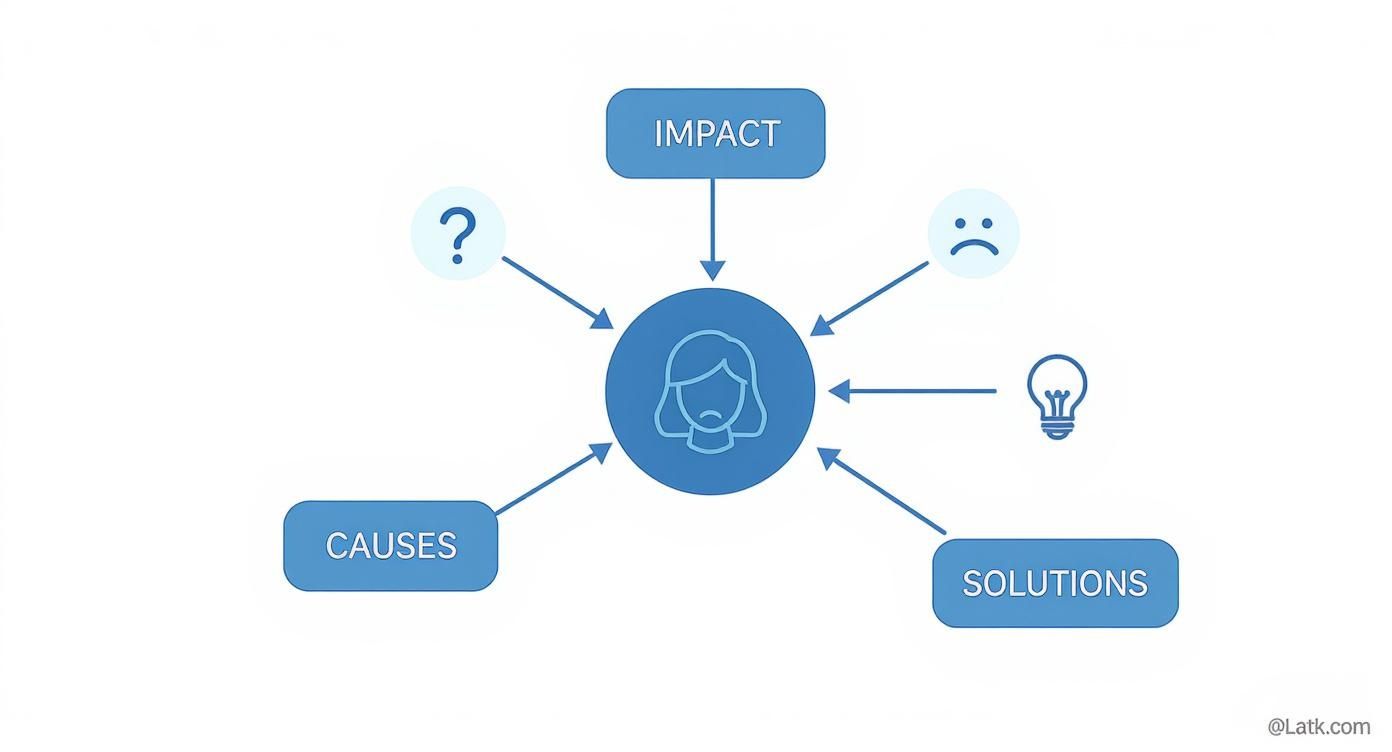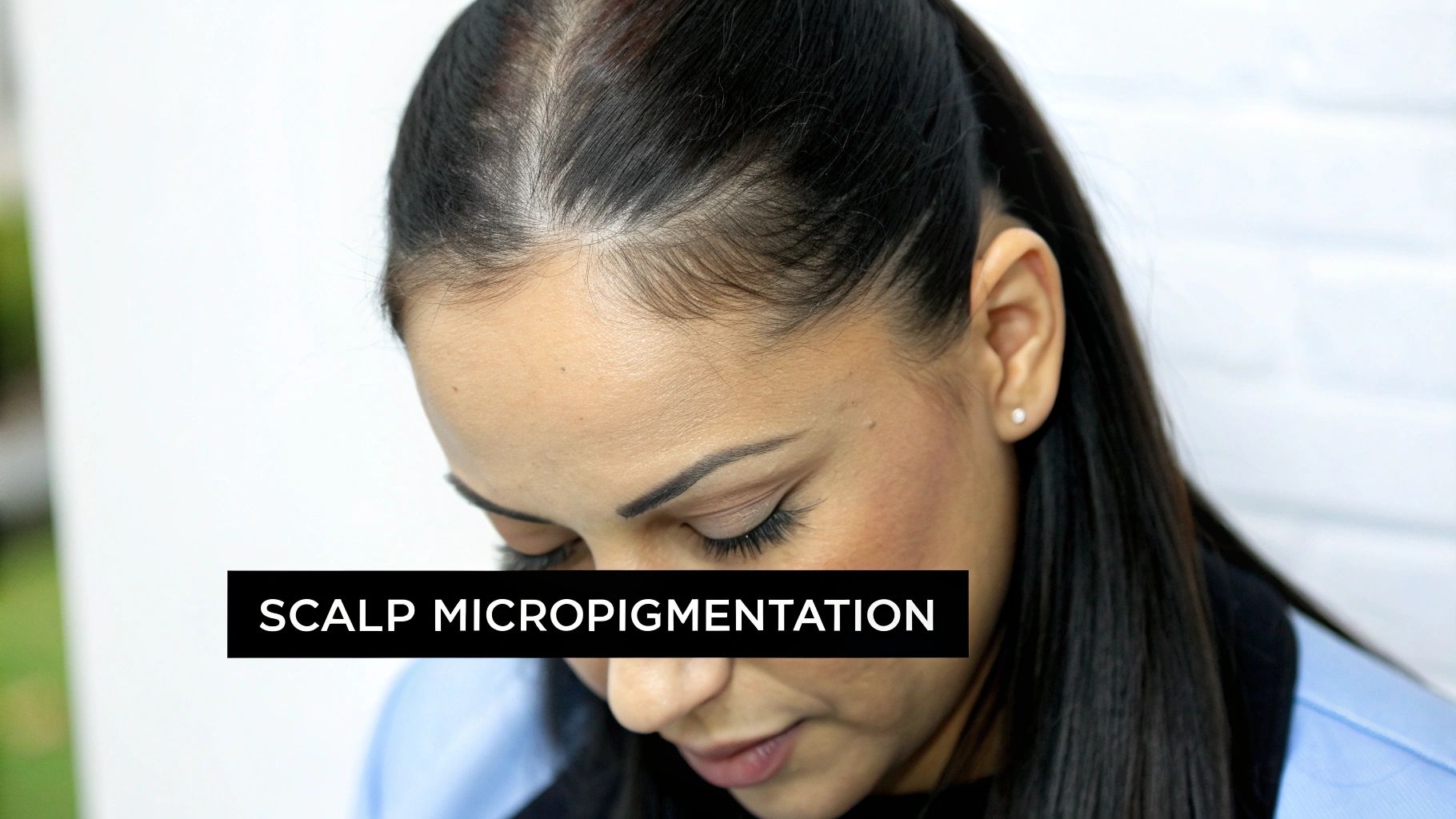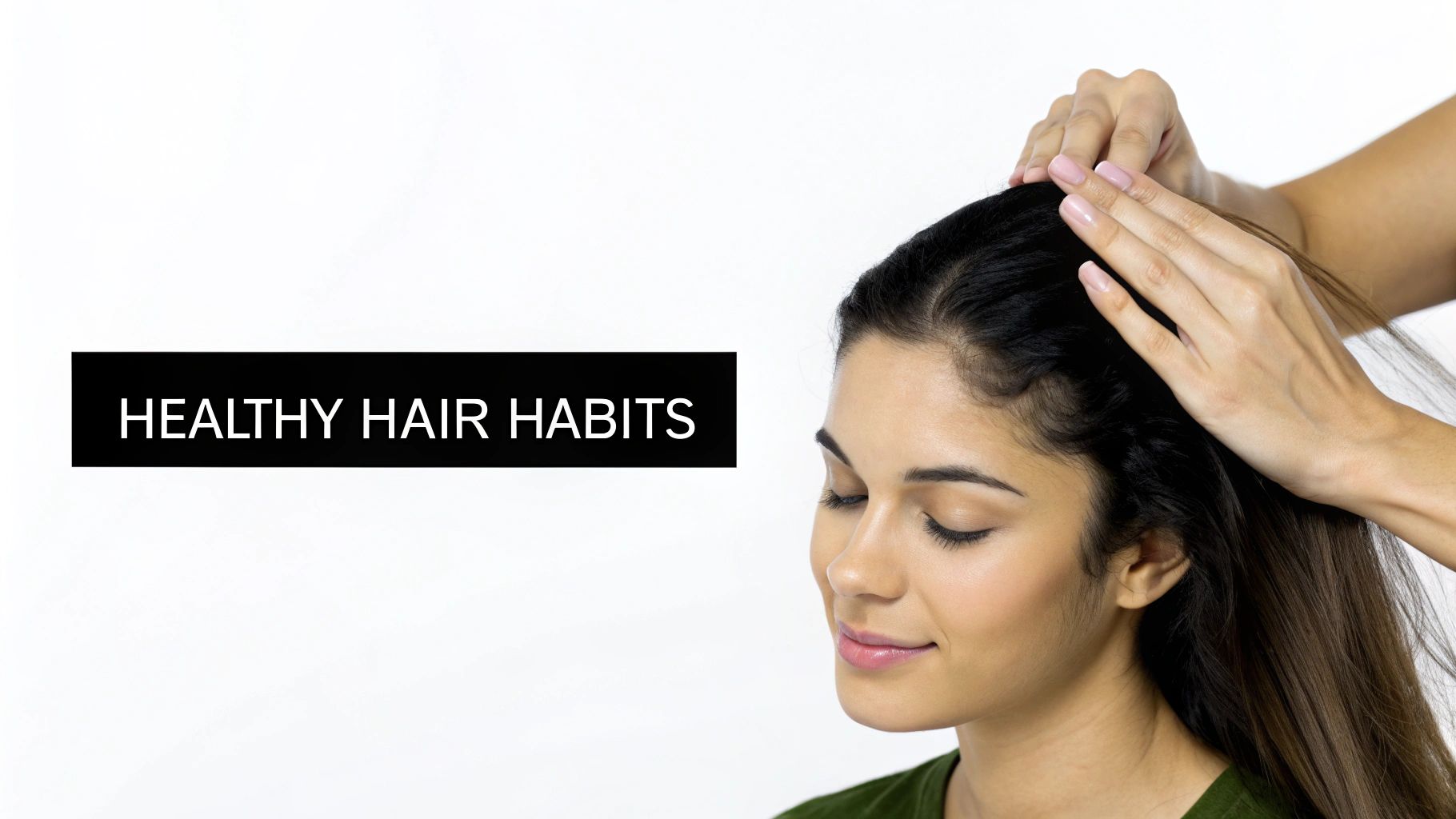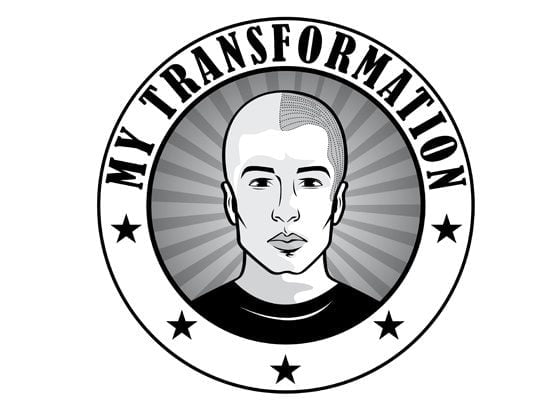
hair thinning and balding in women: potential causes and treatment options
Share
Seeing more hair on your pillow or in the shower drain can be an incredibly unsettling experience, but it’s one that so many women share. If you're feeling worried or alone, this guide is here to offer a safe, informative space to explore why female hair thinning happens and, more importantly, what you can do about it.
The emotional weight of hair loss is real, and it can take a serious toll on self-esteem and confidence. Our goal is to cut through the noise and empower you with clear, evidence-based information. Think of this as your roadmap—we'll cover the 'why' behind hair loss and then navigate the 'what now' of effective solutions.
The Scope of Hair Thinning in Women
First off, know that you are far from alone. This issue is much more widespread than most people realise. The leading cause of hair thinning and balding in women is Female Pattern Hair Loss (FPHL), which you might also hear called androgenetic alopecia.
Research shows that about 49% of Australian women will experience noticeable hair loss at some point in their lifetime, and it becomes more common as we get older.
Of course, knowing where to turn for help is a huge part of the journey. When you’ve done all you can at home, connecting with a professional is the next logical step. For more guidance, check out our guide on finding a hair specialist for alopecia.
Acknowledging hair loss isn't about admitting defeat. It's about taking the first powerful step towards a solution that helps you feel like yourself again. The right information and support can make all the difference.
To give you a quick overview, we've put together a simple table that connects common causes with their typical treatment paths. We'll dive much deeper into each of these points, but this is a great starting point.
Quick Guide to Female Hair Loss Causes and Treatments
| Potential Cause | Common First-Line Treatment Approach |
|---|---|
| Genetics (FPHL) | Topical Minoxidil, oral anti-androgens (e.g., Spironolactone), low-level laser therapy (LLLT). |
| Hormonal Changes | Addressing the underlying condition (e.g., thyroid medication), oral contraceptives, or supplements. |
| Nutritional Deficiencies | Dietary changes, iron or vitamin supplements (as guided by blood tests). |
| Stress (Telogen Effluvium) | Stress management techniques, gentle hair care, and patience for the hair to regrow. |
| Autoimmune Conditions | Corticosteroid injections or topical treatments prescribed by a dermatologist. |
This table provides a snapshot of the options available. Now, let's get into the details of what’s really going on and what each of these treatments involves.
Why Is My Hair Thinning? Unpacking the Causes
Figuring out why your hair is thinning can feel like solving a complex puzzle. More often than not, the biggest piece of that puzzle is a condition called Androgenetic Alopecia, which you might know as Female Pattern Hair Loss (FPHL). You can think of it as a pre-written genetic script that gets passed down through the family.
This script makes specific hair follicles on your scalp extra sensitive to hormones called androgens, especially dihydrotestosterone (DHT). Over time, this sensitivity causes the follicles to shrink. They start producing finer, shorter hairs until, eventually, they just stop growing. This slow process is called miniaturisation, and you might first notice it as a widening part line or just a general lack of volume.
The Role of Hormones and Health
While your genes might set the stage, it's often your hormones that direct the show. Any fluctuation in your body's delicate hormonal balance can either trigger or speed up hair thinning. It’s no surprise that major life stages and health conditions are common culprits.
For Australian women, hair thinning and balding can stem from a whole range of factors beyond just genetics and getting older. We see hormonal shifts, various medical conditions, and even lifestyle changes playing a big part. Things like polycystic ovary syndrome (PCOS), autoimmune disorders such as alopecia areata, and even post-viral syndromes are all known contributors. Endocrine disruptions, like a thyroid problem or the changes that come with menopause, are particularly powerful influencers.
Since hormonal shifts are such a key player in female hair loss, getting a handle on these imbalances through targeted nutrition can be a really important step. For more on this, check out this practical guide to hormone balance supplements for women.
This concept map helps break down the complex experience of female hair loss into its causes, its impacts, and the solutions available.

As you can see, hair loss is a multifaceted issue. Understanding the root cause is always the first, most crucial step toward finding a solution that works and managing the emotional side of things.
When Stress Triggers Sudden Shedding
Sometimes, hair loss isn’t a slow, creeping change but a sudden, alarming amount of shedding. This is often a condition called Telogen Effluvium. It typically happens after your body goes through a significant shock—this could be something physical like surgery or a major illness, or something emotional like a huge life stressor.
Think of it as your body hitting an emergency reset button. The shock pushes a large number of your hair follicles—sometimes up to 30% or more—into the resting (telogen) phase all at once. Then, a few months down the track, all of that hair sheds simultaneously, causing a very noticeable thinning.
Common triggers for Telogen Effluvium include:
- Major surgery or severe illness
- Significant emotional stress
- Childbirth
- Rapid weight loss or extreme dieting
The good news about Telogen Effluvium is that it’s almost always temporary. Once the stressor is gone and your body has had a chance to recover, those follicles will re-enter their growth phase, and your hair will gradually return to its former thickness.
Pinpointing the exact reason for your hair thinning is the key to treating it effectively. A professional diagnosis can help you tell the difference between genetic, hormonal, and stress-related causes, which gets you on the right path from the start. To dive deeper, you can learn more about what causes thinning hair in women in our detailed guide. This knowledge is empowering, helping you understand what’s happening and explore the solutions that are right for you.
Finding the Right Professional Treatment
Once you have an idea of what might be causing your hair thinning, the next step is to explore effective, science-backed solutions with a professional. It can feel overwhelming to navigate all the options, but they generally fall into a few main categories: reactivating follicles, balancing hormones, or stimulating new growth.
Taking that proactive step is becoming more and more common. The Australian hair loss treatment market was valued at USD 133.84 million and is expected to balloon to USD 302.61 million by 2033. This isn't just a random statistic; it shows a massive number of women are successfully seeking and finding solutions. You can dive deeper into these trends and discover insights on imarcgroup.com.
Having an informed chat with your doctor or dermatologist is the single most important thing you can do to get started.
Topical and Oral Medications
One of the most common and accessible starting points is topical Minoxidil. Think of it as a gentle wake-up call for sleepy hair follicles. When applied directly to the scalp, it helps boost blood flow, encouraging those resting follicles to get back into their active growth phase. It’s a proven tool for many women with FPHL, but the real secret is consistency. You have to stick with it.
If your hair loss is tied to hormonal shifts, oral medications can make a huge difference. Spironolactone, for example, is an anti-androgen. It works by essentially shielding your hair follicles from the damaging effects of androgens like DHT, helping to slow or even stop that dreaded miniaturisation process that leads to thinning.
It's essential to remember that medical treatments are a long-term commitment. Results take time, often requiring at least three to six months of consistent use before visible improvements appear. Patience and persistence are your best allies.
Often, these treatments are used together to fight hair loss from multiple angles. For a more detailed look at the medical options out there, our guide on alopecia treatment for women offers some great extra context.
Advanced In-Clinic Procedures
Beyond daily medications, there are some powerful in-clinic procedures that can take your treatment to the next level. These are performed in a professional setting and often use your body's own healing powers or advanced tech to kickstart hair growth.
A couple of popular procedural options include:
- Platelet-Rich Plasma (PRP) Therapy: This fascinating treatment uses a concentrated dose of your own blood platelets, which are little powerhouses packed with growth factors. This "liquid gold" is injected into the scalp to help mend damaged follicles and encourage new, healthy hair to grow.
- Low-Level Laser Therapy (LLLT): This is a non-invasive option that uses medical-grade lasers to deliver light energy straight to the scalp. It's believed this light stimulates the cells inside your follicles, improving blood flow and nudging them back into the growth phase. You can get LLLT treatments in a clinic or even use at-home devices.
The best candidates for these procedures are usually women in the earlier stages of hair loss who still have plenty of follicles that are just dormant, not gone completely. A dermatologist is the best person to assess your scalp and figure out which treatment, or combination of them, will give you the best shot at real results for your specific pattern of hair thinning.
How Scalp Micropigmentation Can Help
While medical treatments are great for actually regrowing hair, they take time. Lots of it. For many women, waiting months to see a change isn't ideal, which is where Scalp Micropigmentation (SMP) comes in. It’s a brilliant cosmetic solution that gives you the look of fuller hair, instantly.
It’s important to understand that SMP doesn’t grow hair. Instead, it masterfully camouflages the thinning you’re experiencing.
Think of it as a highly specialised tattoo, but made just for the scalp. The technique and tools are totally different from a standard body tattoo. A trained practitioner uses a micro-fine needle to deposit thousands of tiny pigment dots into the upper dermis of your scalp.
These dots are layered to look exactly like natural hair follicles, creating a subtle ‘shadow’ effect. This clever illusion darkens the scalp, making the contrast between your hair and skin far less obvious. The result? Your hair instantly appears denser and thicker, which is a lifesaver if you’re dealing with diffuse thinning or a widening part.

Why SMP Is a Great Option for Women
The biggest win with SMP is the immediate result. You walk out of your first or second session with thinning patches dramatically less noticeable, giving you a massive and much-needed confidence boost. It completely changes how you feel about your hair day-to-day.
But it’s not just about the instant camouflage. SMP has a few other key advantages for women dealing with thinning hair:
- Non-Invasive: Forget surgery. SMP is a non-invasive treatment with very little discomfort and no real downtime.
- Low Maintenance: Once your sessions are done, the results last for years with minimal upkeep.
- Safe and Effective: The pigments are hypoallergenic, specially made for the scalp, and designed to hold their colour without blurring over time.
- Works With Your Hair: SMP doesn't interfere with or damage your existing hair follicles. It just blends in to make everything look fuller.
Scalp Micropigmentation is a fantastic way to regain control over your appearance while pursuing other medical treatments. It provides an immediate cosmetic fix that can help you feel more like yourself as you wait for longer-term hair growth solutions to take effect.
A Complementary and Flexible Approach
One of the best things about SMP is how well it plays with other treatments. You can easily and safely have SMP while also using topical Minoxidil, taking prescription medications, or undergoing PRP therapy.
This flexibility makes it a perfect piece of a larger hair restoration puzzle. While your medical treatments are working behind the scenes to encourage new growth, SMP has you covered on the outside, making sure your hair looks dense and full right now.
If you’re curious about the nuts and bolts of the procedure, you can learn more about what scalp micropigmentation is and see how it’s customised for different types of hair loss. It’s a strategy that gives you both a long-term plan and an immediate solution.
Building a Hair-Healthy Lifestyle at Home
While clinical treatments are powerful, what you do every day lays the groundwork for healthy hair. Creating a supportive routine at home can make a huge difference in managing female hair thinning, complementing any professional therapies you’re undergoing and helping you hold on to the hair you have.
Think of your hair follicles like tiny, delicate plants. To flourish, they need the right nutrients from the soil and gentle care—not a harsh environment. It’s a holistic approach that truly starts from the inside out.

Nourishing Your Hair from Within
What you eat has a direct line to the strength and vitality of your hair. A balanced diet, packed with specific vitamins and minerals, is absolutely non-negotiable for a healthy hair growth cycle. In fact, deficiencies in key nutrients are a well-known culprit behind excess shedding and weak hair.
Try to consciously include these hair-health heroes in your daily meals:
- Iron: This mineral is vital for producing haemoglobin, which is responsible for carrying oxygen to all your body’s cells—including the ones that kickstart hair growth. You’ll find it in lean red meat, spinach, lentils, and fortified cereals.
- Protein: Your hair is made almost entirely of protein, so it makes sense that not getting enough can leave it brittle and weak. Make sure you’re getting plenty from sources like chicken, fish, eggs, and legumes.
- Biotin and Zinc: These two are powerhouses for producing strong, healthy hair. Nuts, seeds, and whole grains are fantastic sources.
Supplements can sometimes offer an extra boost, but it's important to know what you're taking. For a deeper dive, it's worth understanding effective supplements for hair loss.
Gentle Care and Stress Management
How you treat your hair on the outside is just as crucial as what you put inside your body. Aggressive styling, heat, and harsh chemical treatments can cause breakage, which makes already thinning hair look even sparser. A gentle hair care routine is a simple change with a big impact.
This means putting the straighteners and curling wands on a lower setting (or away altogether some days), avoiding tight ponytails or buns that pull at the scalp, and always using a wide-tooth comb on wet hair. These small shifts reduce the physical stress on your strands and can make a world of difference.
Stress management is another massive piece of the puzzle. Chronic stress can prematurely push a large number of hair follicles into their resting (or shedding) phase, leading to a sudden increase in hair fall a few months down the line.
Finding a healthy outlet for stress is key. It doesn’t have to be complicated—it could be a daily walk, mindfulness meditation, yoga, or even just a few minutes of deep breathing. By calming your nervous system, you help create a stable internal environment where your hair can stay in its growth phase for longer. For more ideas on this, take a look at our guide on how to prevent hair loss naturally.
Your Hair Loss Questions, Answered
When you're dealing with hair thinning, it's natural to have a lot of questions. Let's cut through the noise and get straight to the answers you're looking for, drawing on what we know about the causes and treatments for female hair loss.
Can Stress Alone Cause Permanent Balding in Women?
Significant stress can definitely trigger a massive shed, a condition known as telogen effluvium. It's your body's way of hitting the emergency brake, diverting resources away from things like hair growth to deal with what it perceives as a major threat.
But here’s the good news: this type of hair loss is almost always temporary. Once you manage the stress and your body finds its balance again, your hair follicles wake back up and return to their normal growth cycle. It doesn't cause the permanent follicle damage that you see with genetic hair loss.
Are Hair Growth Supplements Actually Worth It?
Supplements can be a game-changer, but only if your hair loss is directly linked to a nutritional shortfall. For instance, if blood tests show you're low in iron, vitamin D, or zinc, taking a targeted supplement can make a world of difference in getting your hair growth back on track.
However, if your thinning is caused by genetics (Female Pattern Hair Loss) or hormones, popping vitamins won't fix the underlying issue. They might support the health of the hair you have, but they won't stop or reverse the primary cause. Always get a confirmation from your doctor before spending money on supplements.
Think of it like this: you wouldn't try to fix a leaky pipe by watering your pot plants more. Supplements are the water; you first need to check if the "pipes"—your internal health—are the real problem.
How Long Until I See Results from Treatments Like Minoxidil?
Patience is key when starting any medical hair loss treatment. With a topical solution like Minoxidil, consistency is absolutely everything.
You’ll need to stick with it for at least three to six months of daily use before you can expect to see the first signs of change. This usually starts as a decrease in shedding, followed by the appearance of fine, new hairs.
The results tend to build from there, often peaking around the 12-month mark. Remember, the treatment is working with your hair's natural growth cycle, which is a slow, steady marathon, not a sprint. It's also crucial to understand that if you stop the treatment, the hair loss will likely return.
Does Colouring My Hair Make Thinning Worse?
This is a worry I hear all the time. The short answer is no—standard hair colouring and gentle styling don't cause hair loss from the root. The real damage comes from habits that physically break the hair shaft, making already thin hair look even sparser.
The main culprits to watch out for are:
- Harsh chemical processes, like over-bleaching, that destroy the hair's integrity.
- Excessive high-heat styling, which literally fries the hair strand.
- Tight, restrictive hairstyles like slicked-back ponytails or tight braids that put constant tension on the follicles, leading to what's known as traction alopecia.
These practices lead to breakage, not true hair loss, but the visual effect is often the same. Being gentle with your hair is one of the best things you can do to preserve its thickness and volume.
At My Transformation, we understand the emotional journey that comes with hair loss. We're here to provide solutions that restore not just your hair, but your confidence. If you're considering your options and want to learn more about Scalp Micropigmentation, we can help. Discover how we can help you with your decision to improve your hair loss situation.
